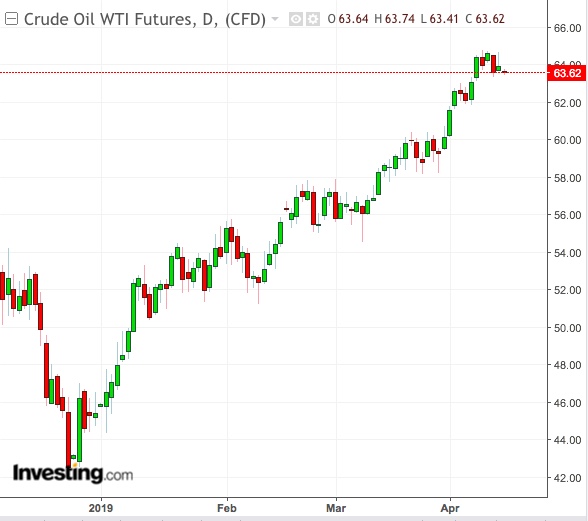Even with bulls expected to continue with their push for $65 U.S. crude and $73 Brent this week, the more discerning longs in the space will watch for signs of Russian reluctance to stay with OPEC production cuts beyond June—an outcome that could seriously weigh on the oil rally.
With gold, the market’s watch will return to the U.S.-China trade negotiations and whether any breakthrough will come on that to prompt more fund flows from the dollar into the precious metal. Outlook for the world economy will also be key, with a flood of data from euro zone trade balance to U.S. manufacturing PMI due.
On the oil front, Russia's Finance Minister Anton Siluanov was quoted by the TASS news agency as saying that Moscow and OPEC may decide to boost output to fight for market share with the United States, although the risk was that oil prices could eventually fall to as low as $40 per barrel from such a move.
Russian Discomfort With Staying In OPEC+ Growing
It’s not the first time the Russians have indicated their discomfort in continuing with production cuts to help Saudi Arabia’s goal of tightening the market further under their so-called OPEC+ arrangement—when global oil supplies are already squeezed by fears of outage from Libya’s civil war and U.S. sanctions on Venezuelan and Iranian oil.
Kirill Dmitriev, the chief of Russia's sovereign wealth fund who engineered Moscow’s cooperation with OPEC, said recently he wanted the country to pump more oil.
But the Saudis, who virtually run OPEC, would like the curbs to remain. Russia's breakeven price for oil is around $42 per barrel, while the Saudis need the market to be at around $84 or more for their national budget.
Igor Sechin, CEO of Russia’s largest oil company Rosneft, is another who’s pushed Russian President Vladimir Putin to end the pact with OPEC, which he described as a strategic threat to Moscow that played into U.S. hands.
Putin has, however, said he wasn't decided on how Moscow's cooperation with OPEC should go.
Saudis Fear Market Overshooting On Hedge Funds’ Bets
The Saudis themselves are aware of the need to raise oil output between now and the next couple of months to prevent the market from possibly overshooting to levels that could spark demand destruction.

While cuts by OPEC+ have been the biggest fundamental driver for this year’s 41% gain in West Texas Intermediate crude and 32% in London-traded Brent, it’s also a fact that a rally of this magnitude wouldn’t have been possible in under four months without the hot money flowing into oil from hedge funds and other money managers.
And with signs that hedge funds have a lot more appetite to continue with their allocations to oil, there is real danger that the market could overshoot and control over price could shift from OPEC’s hands to that of fund managers.
U.S. crude exports, which hit record highs of 3.6 million barrels per day in March, have also found their way to major Saudi customers like Indian Oil. U.S. crude production itself is estimated to be at record highs of around 12.2 million barrels per day versus Saudi output, which is at least 20% below norm now.
Yet, the Saudis are fearful that any announcement of them suspending cuts could spark an instant reversal in hedge fund positions that may cause them to lose more on a barrel than imagined.
While Russian Finance Minister Siluanov may sound like an alarmist with his warning that oil could slide back to $40 levels, Riyadh has too much of a stake to make a wrong move, say analysts.
Caught Between A Rock And Hard Place
Dominick Chirichella, director of risk and trading at the New York Energy Management Institute, implied in his weekend note that the Russians and Saudis were caught between a rock and a hard place in wanting to prevent further loss of market share to U.S. crude from their production cuts, while ensuring global oil prices don’t fall too far from where they are now.
Said Chirichella:
“Barring any new geopolitical events further impeding supply, OEPC has hinted that at their June meeting, they would discuss triggers that could move them and their partners to increase production.”
“At the June 25/26 policy meeting, they plan to look at the level of prices as well if supply continues to decline due to evolving geopolitical events in many producing countries. This could result in a cap on prices as unlimited movement to the upside will eventually have a negative impact on global economic growth and thus global oil demand growth.”
In spite of such plans, Chirichella doubts Riyadh will make a call to halt cuts unless its hand is forced.
He wrote in his weekend commentary that even though OPEC has lost market share to the U.S. in recent months, “higher prices and the destocking of global oil stocks is a more important objective.”
Added Chirichella:
“Back in 2014, when OPEC decided to support market share in the face of rising U.S. crude oil production, it turned out to be a financial failure with the spot WTI prices moving into a downtrend hitting a low of $26.05 in February of 2016.”
“Compared to the February 2016 low, the spot WTI price is now higher by $37.84, or 145 percent”
Thus, he concluded:
“I expect OPEC will continue to focus on a price-supporting strategy at the expense of market share for the foreseeable future.”
